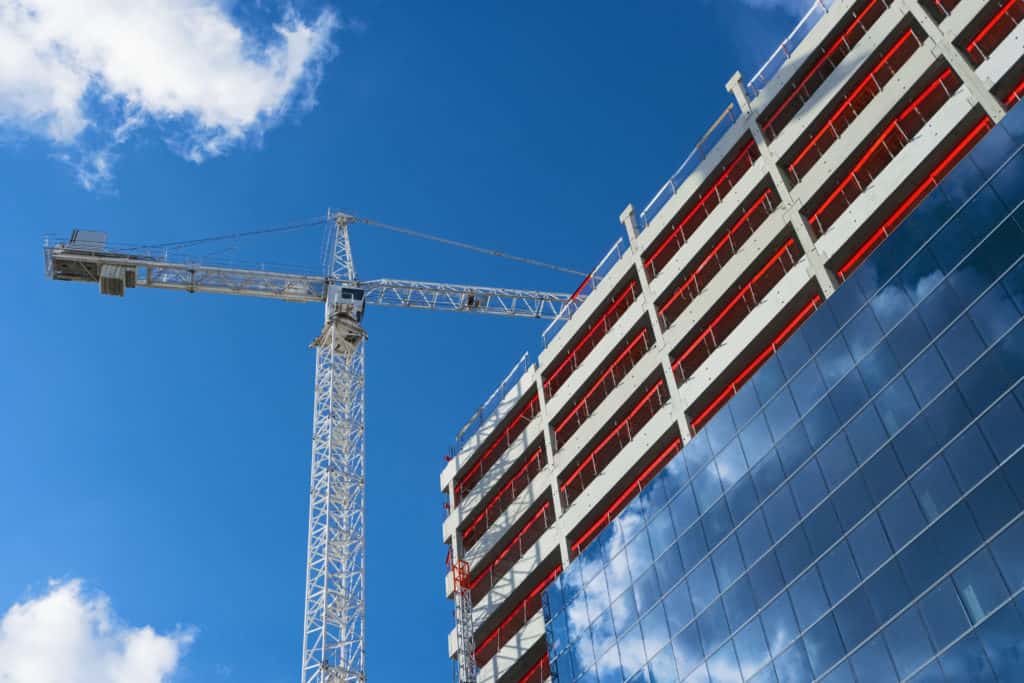In the realm of architecture, each project is unique – and along with every individual project comes its own cost-driving program elements.
Apartment buildings are no exception to this rule, as they can be as simple as a 3-story walk-up or as complex as an urban development project with various construction limitations.
At the initial stage of budgeting, RSMeans data can be implemented for background information. However, construction costs for apartment buildings cannot always be pinpointed to an absolute number, particularly in areas where the housing boom has sharply increased construction costs and skilled labor shortage.
In many cases, firms will use historical data from past projects and extract common elements to the proposed project. As construction costs for apartment buildings vary based on variables such as economic and market trends of the current year and the location they’re constructed in, determining an average national cost can become somewhat elusive.
In this article, we’ll explore the variables found in commercial construction across the U.S., along with tips and tools to estimate the cost of building a commercial apartment building.
Table of Contents
Commercial Construction: Cost-Estimating For U.S. Apartments

When it comes to determining the cost of commercial apartments, many factors must be taken into consideration, including building practices, the cost of labor, the cost of land, and to some extent, the cost of the materials.
Because these tangential costs can differ significantly from location to location and depend on the nature of the particular apartment building, it is difficult to provide a one-size-fits-all answer.
Although the National Association of Home Builders (NAHB) can provide a broad idea of construction costs for an average home, it is not ideal for estimating costs for a commercial apartment building.
Companies that provide more specific cost estimating, usually for a fee, include RSMeans and Marshall & Swift.
These costs include all of the builder’s expenditures that go into a particular item, including labor costs paid directly by the general contractor, hiring subcontractors, and the cost of materials.
So, what does it cost to build an apartment complex?

As mentioned, there are many variables – for example, apartments come as low-rise, mid-rise, and high-rise architectural styles.
For this discussion, we will look at the mid-rise buildings with five or more units in each.
According to the U.S. Energy Information Administration, the size of the average apartment is 861 square feet, which assumes a "footprint" of approximately 24'x35'.
The building of a single mid-rise complex would never be a "DIY" project. It typically requires a knowledgeable contractor, an architect, and a subcontractor team, and a cooperative owner to get the job completed within a calendar year.
A twelve unit apartment complex
Utilizing mid-range materials, a regular foundation with full basement, efficient doors and windows, all appliances, and "turnkey" finishing would run at an average of $64,575 to $86,100 per unit to complete, not including acquisition of land.
The above figures place this construction at an $85 and $200 per square foot cost. However, the national average stands at $125 for most contractors. This pricing structure assumes that carpenters, masons, and excavators charge an average of $70 per hour, electricians between $65 to $85 per hour, painters between $20 and $35 per hour, and plumbers between $45 and $65 per hour.
This building would not come in at a simple cost of $85 per square foot; this is due to the excessive construction required on the interior.
A three-story unit of masonry construction with twelve apartments would run roughly $9.4 million in total costs.
The cost excludes land acquisition and site improvements (e.g., parking, landscaping, and play areas). Materials would cost around $4.65 million, labor would cost roughly $4.51 million, machine costs would stand at roughly $232,000, and the contractor would take in over $1.3 million for the project.
Cost Breakdown: What Is Included?
Most owners rely on both an architect and a contractor, and the architect will require approximately 10 – 17% of the total building budget.
Below is a breakdown of services each professional traditionally provides, along with an overview of what to expect in a general commercial apartment buildout:
An architect will:
- Determine the scope of the project and establish a preliminary budget
- Draft list of proposed work, budget, and outline of plans
- Create the schematic design and draft floor plans with elevation drawings
- Work with structural engineers and meet with planning agencies to verify any requirements
- Finalize drawings and incorporate all details about materials and finishes, any fixtures or equipment, and all systems in the structure
- Serve as the project manager and review the plans with any required local agencies while also obtaining necessary permits (if contractors are to be used, it is at this point that they must be selected)
- Serve in an advisory capacity to choose a contractor and help the client through the bid review process
- Complete construction documents and obtain the building permit
- Administer the construction, ensure that contractor's requests for payments are accurate, and confirm all final details are corrected or finished by the contractor
A contractor will:
- Provide the services and materials required for the entire job
- Hire subcontractors according to need
- Suggest plans and ideas to architect/owner to help them meet goals
- Deliver final cleanup of the entire job site
- Pull all permits for work and utility installation
A general apartment construction project will cover such items as:
- Bath Fixtures
- Built-In Appliances
- Cabinets
- Carpeting
- Countertops
- Doors
- Excavation
- Exterior Finish
- Exterior Trim
- Final Cleanup
- Finish Carpentry
- Finish Hardware
- Flooring
- Foundation, Piers, Flatwork
- Heating and Cooling Systems
- Insulation
- Insurance
- Interior Wall Finish
- Lighting Fixtures
- Painting
- Permits and Utilities
- Plans and Specs
- Plumbing Fixtures
- Plumbing Rough-in and Connection
- Roofing, Flashing, Fascia
- Rough Carpentry
- Rough Hardware
- Unit Heating and Cooling
- Windows
- Wiring
Did You Know…
The shape of the outside perimeter is also an important consideration in estimating the total construction cost.
Generally, the more complex the shape, the more expensive the structure per square foot of floor area.
The shape classification of multiple story or split-level structures is based on the outline formed by the outermost exterior walls, regardless of the varying level. Most structures have 4, 6, 8, or 10 corners. Small insets not requiring a change in the roof shape can be ignored when determining the shape.
Points Of Interest: Examining Apartment Construction Pricing Based On Real Estate

- Only half the costs come from physical construction (37%) and land (19%) that you can see and touch in a building. The remainder of the total is soft costs (24%) and expected equity return for the investors (25%).
- A real estate developer loses approximately 15% of the total building’s space for inefficiencies and common areas (e.g., hallways, elevator and exhaust shafts, residential lobby, etc.). Therefore, a 1,000 gross square foot construction turns into an 850 net square foot 2-bedroom, 2-bathroom apartment. The 15% loss factor increases the price per square foot, equivalent to approximately $65,000 per unit for space everyone uses in the building, but no one is thinking they are paying for when they purchase a condo.
- The profit to the equity investor is the second-largest driver of residential pricing. Although the real estate developer may lead and manage the project and is often the face of the development, the developer generally is not the primary capital provider in the project.
For instance, in the 30-unit apartment development described above, the developer would have to invest $4,500,000 of equity (i.e., $150,000 per unit or 35% of the total cost).
Most real estate developers would not invest all of the capital themselves, especially if they have a few real estate projects underway at any one time. Instead, they raise the equity capital, usually from an investment fund, and those outside investors put up 80-90% of the money (e.g., $3,600,000 to $4,050,000 of the total).

Remain Proactive To Avoid Cost Overruns
It is crucial to prepare for cost overruns when determining the costs for constructing a new apartment building.
If you can actively remember that an apartment’s finished cost is often more than the original bid price, you can work to avoid this outcome. In some instances, budgets can be eaten up quickly on high-end materials, such as flooring, vaulted ceilings, elaborate landscaping, and so on.
However, the investment made in such luxury fixtures and materials can be recouped as your property’s price increases exponentially, both in real estate value and as a source of income (i.e., higher rental potential).
A ‘change order’ refers to when something is chosen that is outside the contract. If you are working with an experienced builder, they should quantify these upcharges for you so you can make an informed decision.
Start by working with your new home builder to create as detailed a construction contract as possible. The more detail this contact reveals, the more accurate your estimated new apartment building costs will be, and the more likely you are to stay within your budget.
Some key components to identify in your contract should include:
- Green material costs
- How a garage, outbuilding, or basement might be included/handled in the contract
- How you define heated or unheated spaces
- If the land is included in the square footage costs
- Inflation for a delayed build
- Landscaping costs
- Liability insurance costs
- Realistic allowances
- Septic system costs
- Sidewalk costs
- Subcontractor costs
- Utility connection costs
Summary
Although there are wide variances in cost for commercial apartment construction, one thing is for sure – with the proper planning and budgeting in place at the onset of your project, you can achieve your goals while staying within budget. In the end, it makes good business sense to figure in an additional 10% to cover unexpected costs; however, a seasoned commercial builder should be able to help you adhere to your budget.

